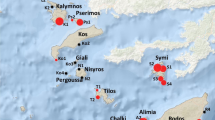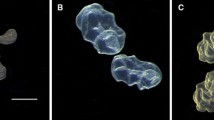Abstract
The horned sea star (Protoreaster nodosus) is relatively common in the Indo-Pacific region, but there is little information about its biology. This study of the population biology of P. nodosus was carried out in Davao Gulf, The Philippines (7°5′N, 125°45′E) between September 2006 and May 2008. Protoreaster nodosus was found in sand and seagrass dominated habitats at a mean density of 29 specimens per 100 m2 and a mean biomass of 7.4 kg per 100 m2, whereas a significantly lower density and biomass was found in coral and rock dominated habitats. Adult specimens (mean radius R = 10.0 cm) were found at depths of 0–37 m, whereas juveniles (R < 8 cm) were only found in shallow sandy habitats with abundant seagrass (water depth ≤2 m). Increased gonad weights were found from March to May (spawning period), which coincided with an increasing water temperature and a decreasing salinity. Density and biomass did not change significantly during reproduction, but sea stars avoided intertidal habitats. All specimens with R > 8 cm had well developed gonads and their sex ratio was 1:1. Protoreaster nodosus grew relatively slowly in an enclosure as described by the exponential function G = 7.433 e−0.257 × R. Maturing specimens (R = 6–8 cm) were estimated to have an age of 2–3 years. Specimens with a radius of 10 cm (population mean) were calculated to have an age of 5–6 years, while the maximum age (R = 14 cm) was estimated as 17 years. Potential effects of ornamental collection on the sea star populations are discussed.






Similar content being viewed by others
References
Babcock RC, Mundy CN, Whitehead D (1994) Sperm diffusion models and in situ confirmation of long-distance fertilization in the free-spawning asteroid Acanthaster planci. Biol Bull 186:17–28. doi:https://doi.org/10.2307/1542033
Bos AR, Gumanao GS, Salac FN (2008a) A newly discovered predator of the crown-of-thorns starfish. Coral Reefs 27:581. doi:https://doi.org/10.1007/s00338-008-0364-9
Bos AR, Alipoyo JCE, Cardona LT, Gumanao GS, Salac FN (2008b) Population structure of common Indo-Pacific sea stars in the Davao Gulf, Philippines. In: Proceedings of 9th biannual meeting philippine association of marine science. UPV J Nat Sci 13 (accepted)
Carpenter PH (1884) Report upon the Crinoidea collected during the voyage of HMS Challenger during the years 1873–1876. Part I: General morphology, with descriptions of the stalked crinoids. Rept Scientific Results HMS Challenger (s: Zool.) 11:1–422
Clark AM, Rowe FEW (1971) Monograph of shallow-water Indo-West Pacific echinoderms No. 690. British Museum (Nat. Hist.), London
Colin PL, Arneson C (1995) Tropical pacific invertebrates. Coral Reef Press, California
Feder HM, Christensen AM (1966) Aspects of asteroid biology. In: Boolootian R (ed) Physiology of echinodermata. Wiley, New York, pp 87–127
Guzmán HM, Guevara CA (2002) Annual reproductive cycle, spatial distribution, abundance and size structure of Oreaster reticulatus (Echinodermata: Asteroidea) in Bocas del Toro, Panama. Mar Biol (Berl) 141:1077–1084. doi:https://doi.org/10.1007/s00227-002-0898-2
Hamel JF, Mercier A (1995) Prespawning behavior, spawning, and development of the brooding starfish Leptasterias polaris. Biol Bull 188:32–45. doi:https://doi.org/10.2307/1542065
Klumpp DW, Salita-Espinosa JT, Fortes MD (1993) Feeding ecology and trophic role of sea urchins in a tropical seagrass community. Aquat Bot 45:205–229. doi:https://doi.org/10.1016/0304-3770(93)90022-O
Lamare MD, Stewart BG (1998) Mass spawning by the sea urchin Evechinus chloroticus (Echinodermata: Echinoidea) in a New Zealand fiord. Mar Biol (Berl) 132:35–140. doi:https://doi.org/10.1007/s002270050379
McCarthy DA, Young CM (2004) Effect of water-borne gametes on the aggregation behavior of Lytechinus variegatus. Mar Ecol Prog Ser 283:191–198. doi:https://doi.org/10.3354/meps283191
Metaxas A, Scheibling RE, Young CM (2002) Estimating fertilization success in marine benthic invertebrates: a case study with the tropical sea star Oreaster reticulatus. Mar Ecol Prog Ser 226:87–101. doi:https://doi.org/10.3354/meps226087
Moran PJ (1988) Crown-of-thorns starfish: questions and answers. Australian Institute of Marine Science, Townsville
Moran PJ, Bradbury RH, Reichelt RE (1988) Distribution of recent outbreaks of the crown-of-thorns starfish (Acanthaster planci) along the Great Barrier Reef, 1985–1986. Coral Reefs 7:125–137. doi:https://doi.org/10.1007/BF00300972
Scheibling RE (1980a) Abundance, spatial distribution and size structure of populations of Oreaster reticulatus (Echinodermata: Asteroidea) in seagrass beds. Mar Biol (Berl) 57:95–105. doi:https://doi.org/10.1007/BF00387375
Scheibling RE (1980b) Abundance, spatial distribution and size structure of populations of Oreaster reticulatus (Echinodermata: Asteroidea) on sand bottoms. Mar Biol (Berl) 57:107–119. doi:https://doi.org/10.1007/BF00387376
Scheibling RE (1981a) The annual reproductive cycle of Oreaster reticulatus (L.) (Echinodermata: Asteroidea) and interpopulation differences in reproductive capacity. J Exp Mar Biol Ecol 54:39–54. doi:https://doi.org/10.1016/0022-0981(81)90101-5
Scheibling RE (1981b) Growth and respiration rate of juvenile Oreaster reticulatus (L.) (Echinodermata: Asteroidea) on fish and algal diets. Comp Biochem Physiol 69A:175–176
Scheibling RE (1982) Habitat utilization and bioturbation by Oreaster reticulatus (Asteroidea) and Meoma ventricosa (Echinoidea: Spantagoidea) in a subtidal sand patch habitat. Bull Mar Sci 32:624–629
Scheibling RE, Metaxas A (2008) Abundance, spatial distribution, and size structure of the sea star Protoreaster nodosus in Palau, with notes on feeding and reproduction. Bull Mar Sci 82:211–235
Schoppe S (2000) Echinoderms of the Philippines. Times Edition, Singapore
Shuman CS, Hodgson G, Ambrose RF (2005) Population impacts of collecting sea anemones and anemonefish for the marine aquarium trade in the Philippines. Coral Reefs 24:564–573. doi:https://doi.org/10.1007/s00338-005-0027-z
Thomassin BA (1976) Feeding behaviour of the felt-, sponge-, and coral-feeder sea stars, mainly Culcita schmideliana. Helgol Wiss Meeresunters 28:51–65. doi:https://doi.org/10.1007/BF01610796
Vicentuan KC, Guest JR, Baria MV, Cabaitan PC, Dizon RM, Villanueva RD, Aliño PM, Edwards AJ, Gomez ED, Heyward AJ (2007) Multi-species spawning of corals in north-western Philippines. Coral Reefs 27:83. doi:https://doi.org/10.1007/s00338-007-0325-8
Wabnitz C, Taylor M, Green E, Razak T (2003) From ocean to aquarium. UNEP-WCMC, Cambridge, UK
Williams ST, Benzie JAH (1993) Genetic consequences of long larval life in the starfish Linckia laevigata (Echinodermata: Asteroidea) on the Great Barrier Reef. Mar Biol (Berl) 117:71–77. doi:https://doi.org/10.1007/BF00346427
Acknowledgments
We greatly acknowledge E. Santos and K. Schröder for supporting the initiation of the project. We thank I. Ebol, C. Ganadores, E. Glimada, J. Lagarteja, B. Müller, S. Nitza, S. A. Nitza, D. Padrogane, C. Petiluna, M. Saceda, F. Salac, J. Salinas, I. Santamaria and R. Tejada for supporting the fieldwork. Furthermore, we would like to thank R. Scheibling, B. Wilkinson, and two anonymous reviewers for their comments on an earlier version of this manuscript. We for fine-tuning the English language. We are grateful to the communities from Samal Island and Talikud Island for sharing their knowledge of the local marine resources. The performed experiments complied with the current laws of the Republic of the Philippines.
Open Access
This article is distributed under the terms of the Creative Commons Attribution Noncommercial License which permits any noncommercial use, distribution, and reproduction in any medium, provided the original author(s) and source are credited.
Author information
Authors and Affiliations
Corresponding author
Additional information
Communicated by J.P. Grassle.
Electronic supplementary material
Below is the link to the electronic supplementary material.
227_2008_1064_MOESM1_ESM.doc
Population dynamics, reproduction and growth of the Indo-Pacific horned sea star, Protoreaster nodosus (Echinodermata; Asteroidea)
Rights and permissions
About this article
Cite this article
Bos, A.R., Gumanao, G.S., Alipoyo, J.C.E. et al. Population dynamics, reproduction and growth of the Indo-Pacific horned sea star, Protoreaster nodosus (Echinodermata; Asteroidea). Mar Biol 156, 55–63 (2008). https://doi.org/10.1007/s00227-008-1064-2
Received:
Accepted:
Published:
Issue Date:
DOI: https://doi.org/10.1007/s00227-008-1064-2




